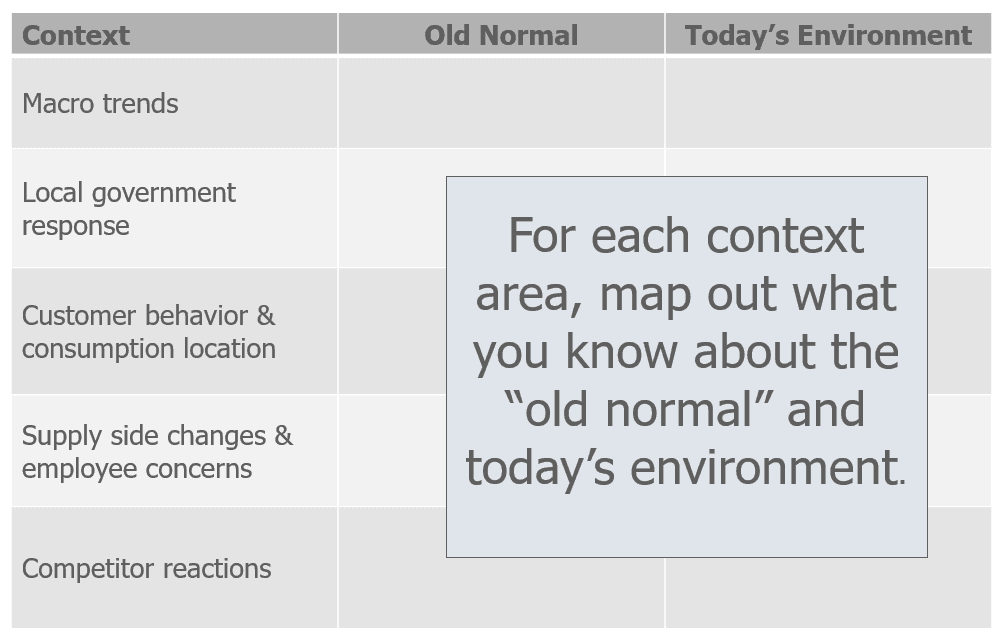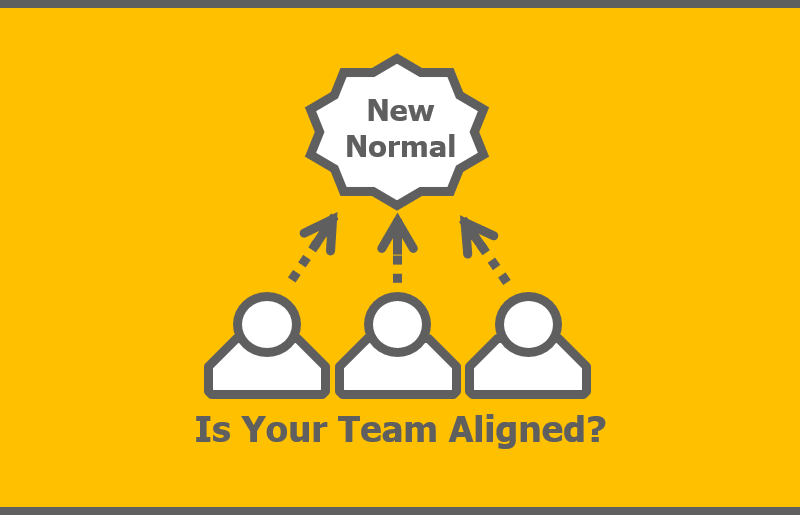One of the challenges of working in a group is getting everyone aligned. We often refer to this as “getting everyone on the same page.” Getting everyone on the same page is one of the primary goals of strategic planning and budgeting processes. These processes help management teams converge on a shared mental model of what they will be doing over the next year.
At the beginning of 2020, every management team had some level of mental model alignment across its members. They had a plan for 2020.
This has all changed in the last six weeks. Whatever level of alignment had been achieved disappeared, along with what we knew as normal. The convergence of two black swans, the coronavirus and the turmoil in the oil market, have caused unprecedented displacements and disruptions to the shape of demand and supply across the economy.
The level of strategic ambiguity is off the charts. Everybody is confused. We all have questions. What will happen next? What do we do now?
Despite the ambiguity, everyone has a perspective or set of views on how this will play out. We cannot help it. Our brains are wired to make predictions about the world around us. It is a fundamental part of how our minds work. We continuously generate mental models of what we expect to see in the world and then update those mental models as we get new information.
Given the uncertainty and pace of change over the past six weeks, it is highly likely that your team has become very misaligned. Each person’s mental model of the world has evolved separately, and you now have a group of people who are not on the same page.
Some leaders will be tempted to dismiss this alignment problem and wait to see what happens.
Proactive leaders will take a different path. They will recognize that while there is significant uncertainty about the future, the possibilities for the future are not limitless. There is a range of possible outcomes.
They will gather their teams and advisors together to map out a robust set of scenarios for the next six to twelve months. They will work those scenarios and build a new shared mental model of how the team will react to different scenarios and what will trigger those reactions.
How to build a shared mental model for navigating the chaos
Scenario planning is one of the best strategy tools for building alignment on how to manage in times of extreme uncertainty.
Conceptually, scenario planning is simple. First, your team imagines a variety of possible scenarios for how the environment will change over time. Then, the team mentally simulates each scenario and builds a plan to respond to the scenario.
Step 1: Mapping out what you know and believe
One of the biggest challenges is building a robust and relevant set of scenarios that capture the full spectrum of trends and uncertainties and how they may vary over time by market segment and geography.
Some macro assumptions like high levels of unemployment and federal government stimulus are likely to be common across all scenarios. The importance of other assumptions will be highly dependent upon the nature of your business. Only you can assess whether issues like social distancing regulations, demand shifts between channels, changes in health care regulations, changes in state and local spending, new consumer behaviors, and changes to supply chains should be considered in your scenarios.
However, every company can go through a similar process to build scenarios to drive strategy discussions.
One place start is to define what is known. You know what the old normal looked like, and you have a view of your current environment. Looking at the old normal and today’s environment through the lens of different contexts can help you tease out some of the details needed to contrast what was from what is. Working through a matrix like the one shown below can help you extract and structure your knowledge in a way that makes it explicit to all members of your team.

Once you have completed that matrix, start to imagine what happens going forward. Go through each row and discuss what is likely to happen going forward.
- Trends tend to accelerate in times of crises – what is happening to the trends relevant to your business. Are they accelerating?
- The local government response varies widely – will they continue to keep people locked down, or will they reopen your part of the economy? There is likely to be uncertainty about how this will play out – if so, what are the best, expected, and worst cases. For many companies, this will be an important part of the scenarios going forward.
- How do you expect your customers to behave going forward? Will the changes in behavior stick, or will they go back to some version of the Old Normal? Where will they consume your products and services going forward? Have they found permanent substitutes for your products? What frustrations do they have that will drive them to seek other behaviors?
- On the supply side, what is happening to your supply chain? Can you insource work that was done by suppliers? How are your employees being impacted? Can you bring them back to the job safely? What changes need to be made to make this happen? How might you reduce the amount of labor in your products and services?
- How are competitors responding? How does our situation compare to their situation? Who will survive and who will thrive?
Once you have gone through this discussion, try to identify the key uncertainties about the future. One of these is how fast the economy will return. Others might be key aspects of customer behavior, such as when will they feel comfortable going into retail shops again or what changes would make them comfortable going back.
Step 2: Use stories to create scenarios
This is where your imagination becomes very important. A scenario is a story about the future. And you need to build a range of stories about different possible futures.
Use the discussion you had in step 1 to build some alternative stories about what will happen to your environment in the next few months and what it will look like a year from now.
One way to do this is to break up your management team into groups and give each group a different set of assumptions about the future. One group might start with the assumption that over the next year, things will return to the old normal and then ask them to build some alternative stories for how things develop if it happens faster or slower.
A second group might be given assumptions that customer behaviors form new habits and discuss what difficulties and frustrations they have with their new habits. For example, if you own a restaurant, you might build a story where customers are doing a lot more cooking, and they keep doing that. What will that feel like for them? What difficulties will they experience? What will they be unhappy about in this new normal? Those difficulties and frustrations may provide you with opportunities for innovation.
Once your groups have built their stories, reconvene and examine the stories you have built. Look for ways to integrate them into 3-4 cohesive stories about the future that look very different from each other.
Step 3: Mentally simulate the scenarios
Take the 3-4 scenarios that you have built and take an imaginary walk through them. What happens as you go forward? How will you know if that scenario is playing out? What data might appear that would tell you this scenario is playing out? How will they impact your business?
How could the value chain be unbundled and re-bundled back together in different ways? What new roles/activities could the customer take on? How would that reshape what we offer?
How can you protect your employees and deliver on your mission? How can you reshape what work means so that you create more meaningful jobs that create more value for everyone?
What actions can you take, and how might they impact the course of the scenario? What if you changed what the customer does? What you do versus what your supplier does?
Go through each of the scenarios – work through these questions. Map out your answers. Do not let your fears stop you from exploring radical changes.
Step 4: Create your action plan
Once you have built your scenarios and simulated each of those futures, you should have much more insight into what might happen and how you will act.
Some of these actions will be common across the scenarios and form the core set of actions for your plan. In every case, this should include monitoring the key data that act as leading indicators that tell you which scenario is playing out.
You will also likely find a few actions that are of material importance but are scenario dependent. Your action plan should address how you will prepare for these eventualities.
Other actions will be contingent on which scenario plays out. For these, define the triggers for action and incorporate that into your environmental monitoring.
Going through this process will make you and your management team much better prepared for whatever may come. And to paraphrase Louis Pasteur, fortune will flow to those who are prepared.
If you have not done something like this, I encourage you to get started, Make sure you do it well as the cost of getting it wrong could be very high.
